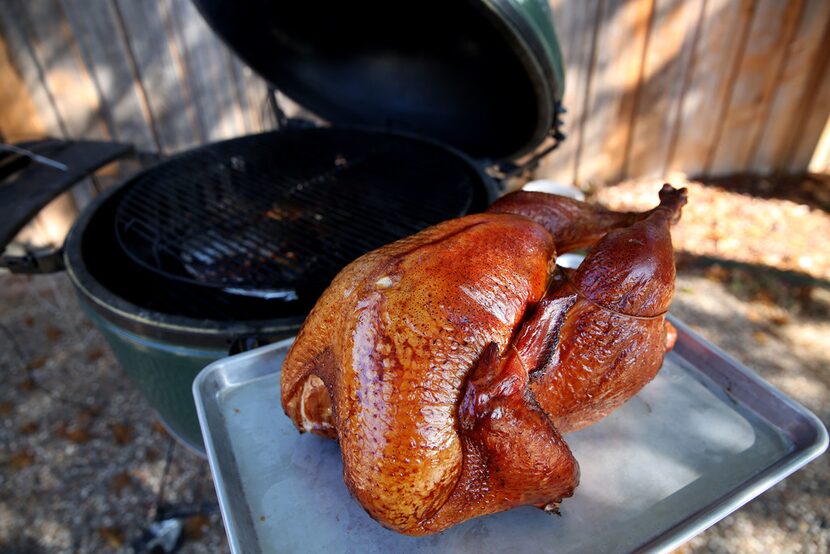Thanksgiving is more than just a holiday of gathering and feasting. It's a holiday of planning and logistics.
Every year the Thanksgiving to-do list looks similar, and the same questions swirl: When should I get the turkey? When do I cook the turkey? How am I going to cook additional food if the turkey is in the oven? What time do we eat?
The turkey tends to be the centerpiece of all the fuss. Deciding where to source your turkey, how to cook it, and who's cooking it — the turkey rules the roost.

Raised on pasture
Back in June, I visited a local farm — Bois d'arc Meat Co. in Windom — to learn how local turkeys are raised on pasture. Isn't Thanksgiving about embracing what the land has provided?

Farmer Thomas Locke and his family raise turkeys, chickens, cows and pigs on pasture, which they sell at the Dallas Farmers Market along with eggs.
"My interest in food is a big reason why I started farming in the first place," Locke says. "We bought our first pasture-raised turkey from the wonderful Eliza MacLean at Cane Creek Farm in Saxapahaw, North Carolina. I was blown away by the difference in flavor from the Butterball of my youth. I didn't know I was going to be a farmer at that point in my life, but once I made that decision, I knew I wanted to raise turkeys for Thanksgiving."
Forget the oven
On Thanksgiving, the turkey usually occupies the most coveted cooking apparatus in the kitchen: the oven. But if you're also making dressing, green bean casserole, roasted veggies and pies, that darned turkey is in the way. To make this juggling act less stressful, I suggest smoking the turkey.
There are plenty of logistical benefits to smoking a turkey: It frees up oven space to allow more items to cook and warm. It opens up more time to cook the side dishes. The kitchen doesn't get as hot (which for Dallas can be a real concern). It allows the Thanksgiving experience to flow outdoors, meaning more room for additional guests.

Get outside
A Thanksgiving dinner centered around a smoked piece of meat is very Texan. It may not be brisket that's cooking low and slow, but it certainly brings a state-honored cooking tradition to the holiday meal.
{"type":"video","title":"Dallas News Video","author_name":"Dallas News","_id":"9sZTRjZDE6XnFFexxe62seezGgmtEmH3","provider_name":"Ooyala","html":"
","raw":"{\"type\":\"video\",\"title\":\"Dallas News Video\",\"author_name\":\"Dallas News\",\"_id\":\"9sZTRjZDE6XnFFexxe62seezGgmtEmH3\",\"provider_name\":\"Ooyala\",\"html\":\"\\u003Cdiv class=\\\"oo-vid-container\\\" data-oo-content-id=\\\"9sZTRjZDE6XnFFexxe62seezGgmtEmH3\\\"\\u003E\\u003C\\/div\\u003E\\u003Cscript defer src=\\\"https:\\/\\/www.dallasnews.com\\/resources\\/motif\\/dist\\/js\\/ooyala.js\\\"\\u003E\\u003C\\/script\\u003E\"}","providerType":"ooyala","providerLink":"https://www.dallasnews.com/oembed","embedType":"video"}
A few thoughts on smoking a turkey:
* Brining the turkey infuses flavor and salt into the bird before the smoking process. This yields a more flavorful slice of meat.
* The overall flavor of the turkey will have a smoky element to it. You can adjust the amount of smoke by adjusting the amount and type of smoking wood you use in the process.
* A grill thermometer is a must. This will help you know when the turkey is finished cooking.
* Use an indirect heat setup for your particular grill. You can find tips and tricks in the owner's manual or online. We used a Big Green Egg.

Smoked Turkey
1 pasture-raised turkey (between 15 and 18 pounds)
1 sprig sage
2 bay leaves
4 sprigs rosemary
1 tablespoon whole peppercorns
1 head garlic, halved
1 onion, quartered
1 apple, quartered
Extra-virgin olive oil
Apple juice, in a spray bottle
Turkey Brine (recipe follows)
Directions:
Make the Turkey Brine: Combine 2 gallons water, 2 tablespoons whole peppercorns, 1 cup brown sugar, 1 1/3 cups kosher salt, 2 sprigs sage, 4 bay leaves, 7 sprigs rosemary, 2 halved heads of garlic, 2 quartered apples and peels from 2 oranges in a large stock pan. Heat the brine until sugar and salt have dissolved, stir occasionally. Remove the brine from the heat and bring to room temperature. Place the turkey in a 32-quart plastic container. Pour the brine over the turkey. Place the turkey in the fridge and let brine for at least 12 hours, up to 24 hours.
Remove the turkey from the brine. Pat dry and set aside.
Prepare the grill for indirect cooking at 250-275 F. Add your preferred smoking wood to the fire while the grill is heating.
Tie the sage, bay leaves and rosemary with kitchen twine.
Stuff the turkey with the peppercorns, herb bundle, garlic, onion and apples.
Lightly coat the turkey with the olive oil.

Place the turkey onto the grill. Spray the outside of the turkey with apple juice. (Spray the turkey with apple juice once more after 2 hours of smoking.)
Insert a grill thermometer into the thickest part of the turkey breast. Close the grill and cook until the temperature reaches 165 F, about 4-5 hours.
Remove the turkey from the grill. Cover with foil and let the turkey rest for 20 minutes.
Remove the ingredients that were placed inside the turkey. Carve and serve.
Smoking tips
After the grill has reached the desired temperature, wait at least 30 minutes prior to adding the turkey. Fifteen pounds of cold mass on the grill can throw off the temperature and may greatly change the cooking time if the grill is not sufficiently heated.
Use a drip pan to collect the drippings for a unique addition to your meal. Be careful when incorporating them into sauces or gravy though: A little smoke flavor goes a long way.
Take a quick peek at the turkey after about 3 hours. If the skin is starting to look done before the thermometer indicates doneness, use some foil to cover those areas to slow the cooking.
Select a smoking wood that pairs well with poultry. I like pecan or fruit wood (apple, cherry, etc). Mesquite and hickory, though very Texan, can overwhelm the turkey. Again, a little goes a long way. Two or three fist-sized chunks should be plenty.
